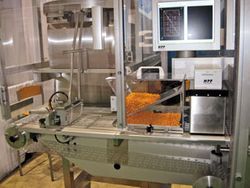Fluid Handling Trends in Biopharmaceutical Processing
Equipment and Processing Report
Manufacturers of peristaltic and diaphragm metering pumps discuss trends in fluid handling for biopharmaceutical manufacturing and some considerations for using different types of pumps.
In a biopharmaceutical process, pumps are needed to move fluids (e.g., buffer, media, and water for injection) through tubing and deliver them to the process equipment. Several types of positive displacement pumps are used, including peristaltic, diaphragm, rotary lobe, and gear pumps. Pharmaceutical Technology spoke with experts at manufacturers of peristaltic and diaphragm metering pumps about some trends in for fluid handling in biopharmaceutical manufacturing and some considerations for using different types of pumps.
Trends in fluid handling
The move to continuous processing is evolving and will affect the requirements for pumps and other process equipment, says Andreas Frerix, product manager Quattroflow, at PSG, a Dover company. Gary Gaudet, technical leader of bioprocessing at LEWA-Nikkiso America, adds that there is a trend to have more self-contained processes, such as combining buffer dilution, clean-in-place systems, and chromatography skids rather than having separate skids. Steam-in-place systems are also being requested more than in the past, he notes.
Both multiple-use and single-use manufacturing systems are employed in biopharmaceutical manufacturing. “Biopharm is naturally risk averse; innovations, therefore, rarely take hold overnight, and the advent of single-use continues to expand into different process areas due to the benefits offered,” says Russell Merritt, marketing manager at Watson-Marlow Fluid Technology Group. “We will continue to see both single-use and hybrid (mixed single/multi use) processes being developed. Peristaltic technology is therefore well positioned to continue to meet customers’ requirements to provide a low-risk fluid handling solution through accurate pumping technology and high quality peristaltic tubing.”
Another trend is an increase in the need for companies to be able to monitor fluid-path processes from remote locations. “The ability to monitor a process remotely allows the process to be run unattended and to notify users when they are complete, so the next campaign can be set up, which helps maintain productivity and improves efficiency,” says Gregg E. Johnson, global senior product manager for the Cole-Parmer peristaltic pump product lines.
Diaphragm pumps
There are different types of diaphragm pumps. Air-operated double-diaphragm (AODD) pumps are used for transferring fluids from one place to another and for ultrafiltration or diafiltration, notes Gaudet. AODD pumps, however, do not have volumetric control. Diaphragm metering pumps, which have highly accurate volume control, are used in processes and for dosing. Applications include: chromatography, buffer inline dilution, homogenization, injection of fluids (e.g., liposomes) into extruders, coating operations, filling, caustic dilution, and aseptic transfer of proteins, cells, and other materials, says Gaudet.
A diaphragm pump uses the reciprocating movement of a flexible diaphragm that decompresses to draw fluid into the pump chamber and then compresses the pump chamber to push fluid out. The diaphragm separates the pump drive from the product-wetted side. This separation means that mechanical seals are not needed, which ensures product safety, simplifies maintenance, and allows the pump to run dry (i.e., without fluid) without being damaged, says Frerix.
Multiple-use pumps have housings made from stainless steel that can be reused after cleaning in place. Multiple-use diaphragm pumps are still commonly used and are meeting customers’ needs, says Gaudet. Single-use diaphragm pumps have chambers made of plastic that have been designed for one process or batch. “After the process, they are replaced with a new chamber and the new process can begin. Single-use pump chambers save money and time by avoiding cleaning and associated cleaning validation and eliminating the risk of cross-contamination between batches or products. Single-use pumps are most valuable if products are changed frequently and fast product changeovers are needed,” says Frerix.
Peristaltic pumps
In a peristaltic pump, the fluid is contained in a single-use tube that is compressed and decompressed by a moving rotor to move the fluid. Tubing is made from biocompatible materials that meet requirements for purity, and the single-use tubing is disposed of after each process to prevent cross-contamination. Because the fluid is completely contained within the tubing and connectors, process validation is simplified, notes Merritt. “Once the pumps are within a cleanroom environment and remain there, no regular cleaning and little maintenance of the pump itself is required.”
Although tubing could be treated as multi-use (i.e., cleaned and sterilized between batches), most tubing is treated as “single-use” because this ensures that no cross-contamination occurs and provides new performance for every batch, says Merritt. “The need to maintain fluid path sterility is a key consideration for handling/changing any component in the fluid path. Sterility is another advantage of single-use tubing. The fluid path is provided assembled and sterile, which minimizes the number of connections which need to be made; each connection presents a risk of the introduction of contamination.”
Peristaltic pumps are easy to install and set-up, says Johnson. Because they don’t need to be primed, they are flexible in where they can be installed in the fluid path. “Monitoring the tubing performance is probably the greatest concern,” says Johnson. “A catastrophic failure can cost the loss of an entire campaign, but it is easily prevented by monitoring the tube life, use of new long-life tubing materials, and a preventive maintenance program to replace or move the tubing to new position.”
Look for more on pumps and best practices for preventive maintenance of single-use tubing for peristaltic pumps in Pharmaceutical Technology’s February 2017 issue.



